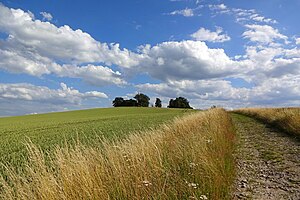Kapellenberg (Schmiedefeld)
| Kapellenberg | ||
|---|---|---|
|
View from Bundesstrasse 6 |
||
| height | 323.1 m above sea level NHN | |
| location | near Schmiedefeld ; District of Bautzen , Saxony ( Germany ) | |
| Coordinates | 51 ° 5 '32 " N , 14 ° 4' 39" E | |
|
|
||
| Type | Knoll | |
| rock | Two mica granodiorite | |
The Kapellenberg is a 323.1 m above sea level. NHN high elevation northeast of the Großharthau district of Schmiedefeld in the Saxon district of Bautzen .
history
In the middle of the 12th century a new traffic route between Dresden and Bautzen was built (following the course of today's federal highway 6 ). After the first settlements had formed along the new road, a Chapel of St. Mary was built around the year 1200 on a mountain near today's village of Schmiedefeld . In the course of the following centuries this chapel fell into disrepair or was demolished, at the latest by the end of the 19th century it had completely disappeared. The name Kapellenberg was retained.
During the spring campaign as part of the Wars of Liberation in 1813, heavy fighting between Napoleonic and Russian troops broke out in and around Schmiedefeld. The Russian artillery had holed up on the Kapellenberg while the French soldiers took up positions in the village. Schmiedefeld was badly damaged by this battle on May 12, 1813. During the autumn campaign in the same year, the Kapellenberg was occupied by Napoleon's troops in the course of a battle near Bischofswerda and provided with heavy field artillery, but the French had to surrender to the Russian and Prussian units and withdraw. An information board on the mountain commemorates the events of 1813.
In 1900 a scaffold for land surveying was erected on the Kapellenberg. Until the 20th century, several quarries were operated on site, in which material for road and house construction in the area was extracted.
Today there is a wooden shelter on the Kapellenberg next to various antenna systems.
Say about the treasure in Kapellenberg
According to legend, there is a huge treasure of gold and precious stones inside the Kapellenberg, which is guarded by a little monk with a gray beard. From time to time the entrance to this treasure chamber should open at night, and whoever enters can take as much of the treasures as they want. However, he is not allowed to speak a word while he is in the mountain. One night a stagecoach driver is said to have seen the bearded man and followed him into the mountain. Although he was instructed to remain silent the whole time, when he had loaded his pockets full of gold and precious stones in the treasury, he was overcome with euphoria and loudly thanked the little monk. Then there was a loud thunder, the little man disappeared, and the mail driver was thrown to the ground by an invisible force and passed out. When he came to he was lying outside the Chapel Hill, and instead of treasure he had only lumps of clay and ordinary stones in his pockets.
literature
- To Stolpen and Neustadt (= values of our homeland . Volume 17). 1st edition. Akademie Verlag, Berlin 1970, p. 25 ff.
- Friedrich Bernhard Störzner: The Kapellenberg near Schmiedefeld . In: What the Heimat tells. Legends, historical images and memorable events from Saxony. Verlag Arwed Strauch, Leipzig 1904, p. 179–181 ( full text at Wikisource ).
Web links
Individual evidence
- ↑ a b Map services of the Federal Agency for Nature Conservation ( information )
- ↑ Contemporary history: Napoleon's troops on the run / Schmiedefeld burns down / Frankenthal suffered particular hardship / Those who had fled did not see their homeland again. Four-part series, published in the Sächsische Zeitung 2003 ( online ).
- ↑ Alfred Meiche: The treasure in the Kapellenberge near Schmiedefeld . In: Sagenbuch des Kingdom of Saxony (publications of the Association for Sächsische Volkskunde) . G. Schönfelds Verlagbuchhandlung, Leipzig 1903, p. 724 ff . ( Online ).


